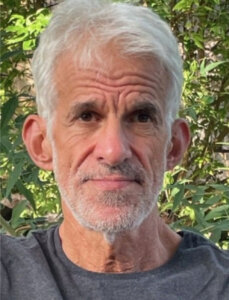In Paris, 80 years after a shocking atrocity, forgetting is another form of extermination
The infamous 1942 roundup was part of a plan to deport more than 23,000 of France’s Jews
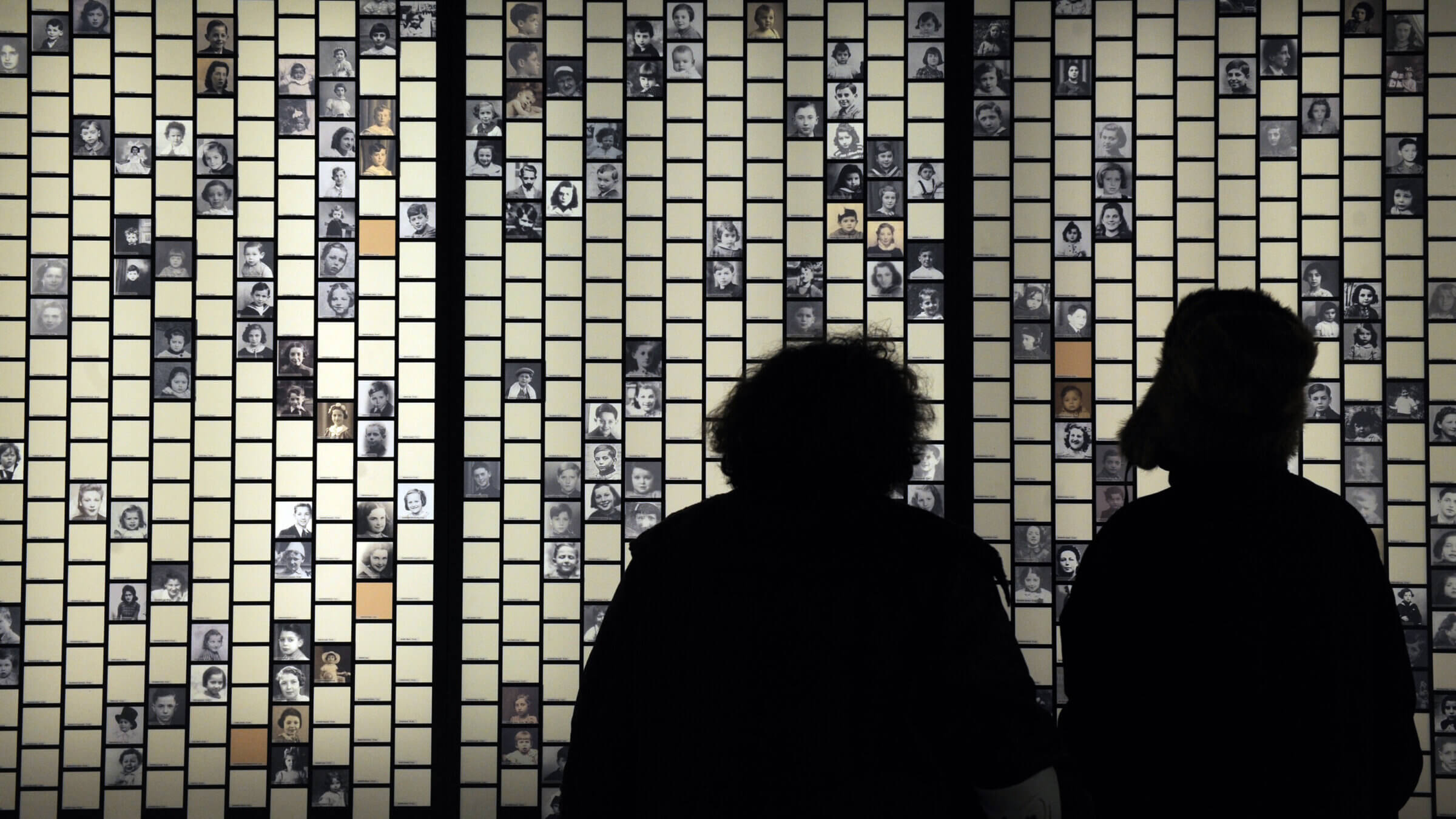
Following the unveiling of a memorial dedicated to the children of the Paris Vel D’Hiv round-up, people look at photographs of the victims. Photo by Getty Images
Though the sun had yet to rise over Paris on the morning of July 16, 1942, this was not the case for more than 4,500 of the city’s uniformed gendarmes and police inspectors. They had not only risen, they were already busy getting others to rise as well. With lists of names and addresses in hand, they had fanned out across the city. Upon entering darkened buildings and climbing stairs, they rapped at doors, at times forcing them open. More than a few of those who answered were wearing coats on which was sewn a yellow Star of David.
So began “Vent printanier,” or “Spring Wind” — the French plan, closely coordinated with Nazi officials, to rid Paris of its foreign Jews.

Eighty years have passed since this infamous “rafle,” or roundup, but the details still shock. Attention to details, in fact, was the great strength of the city’s police prefect, René Bousquet. On July 13, the goals of his so-called “war plan” were communicated to the division commanders. The “occupation authorities,” announced the communiqué, had decided on the arrest and roundup of a “certain number of foreign Jews.” The number of those initially designated for deportation was as precise (23,791) as were their ages (from 16 to 60).
But the numbers required asterisks. Pierre Laval, the head of the Vichy government, ordered that those younger than 16 were not to be separated from their parents. The plan also failed to specify whether the police should consider the physical condition of their prey — or, in fact, if they were even alive. Among the families herded by police onto the streets outside their buildings were not just crying children — many of whom, born on French soil, were French citizens — but, in one case, an infant who, having died the night before, was wrapped in a sheet and carried by its mother.
Scores of other children — including those ill with scarlet fever, typhus and measles — as well as the old and feeble — including a paralyzed woman in a wheelchair — were herded by gendarmes toward designated assembly points. Ordered to take along bedding and clothing, the families made for grim cortèges, with parents shouldering mattresses and clothes bundled up in linens, their children hugging pillows and dolls.
For the next two days, these tableaux were re-enacted across Paris hundreds of times. Nevertheless, “Spring Wind” reached barely half of its stated goal. Thousands of Jews, thanks to warnings from sympathetic gendarmes and Jewish resisters, had acted in time, managing to hide and escape the police, often with the aid of gentile neighbors and friends. Many others in less fortunate circumstances escaped by other means: As many as 100 men and women, facing arrest, instead killed themselves. As for the 13,000 men, women and children who clung to hope, they climbed into the city buses requisitioned by the police. Slightly less than half — single men and women, as well as childless couples — were trundled to a transit camp in the northern suburb of Drancy, while the remainder — composed of families — were taken to the Vélodrome d’Hiver in southeastern Paris.
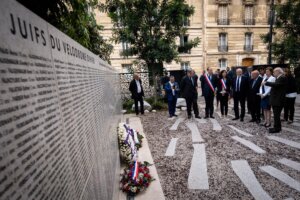
The Vel’ d’Hiv, as it was called, was to early 20th century Paris what the old Madison Square Garden was to New York. Completed in 1909, the vast metallic hangar under whose sweeping skylight cascaded steep rows of concrete and brick bleachers, hosted both sporting and political events. As vélodrome suggests, cycling was immensely popular at the stadium, as was boxing, ice hockey and even bullfighting.
When athletes were not busy wreaking physical mayhem, demagogues were. In 1937, the stadium filled with supporters of the extreme rightwing and antisemitic movement Action française, which gathered to welcome its leader Charles Maurras, newly freed from prison for inciting the attempted murder of prime minister Léon Blum.
After the declaration of war in 1939, the stadium also served as a temporary internment center for German nationals, mostly Jewish, seeking asylum in France. Come May 1940 and the launching of the German military offensive, the Vel’ d’Hiv became a temporary home for hundreds more waves of interned foreign women. No doubt accustomed to the use of the stadium as a holding pen, French officials naturally turned to it a third time.
While the plan for the roundup was meticulous, a plan to care for 7,000 incarcerated human beings was missing. Neither food nor water, latrines nor showers, doctors nor nurses were provided by the authorities. Doctors and nurses from the Red Cross, along with a handful of volunteers, gave what little care they could, all the while ignoring pleas from those who begged for fatal injections.
One of the volunteers, in a letter to her father, described the scene. The moment you enter the stadium, she wrote, “your breath is cut off by a horrid stench, gripping your throat and preventing you from screaming.” The bleachers, meant for sports fans, were now “black with people piled on top of one another, each with about a square foot to lie down.” The air echoed with the cries of children and adults, and the medical team “did not know where to start, especially as the lack of water completely paralyzes us and make us fear an epidemic.” Upon leaving the stadium, officials warned them to say nothing of what they saw. “How disgusting!” she exploded. “They want us to remain silent in the face of this dreadful crime. But no, we will not keep silent!”
Clandestine pamphlets and resistance papers soon began to circulate, recounting what another witness described as a “hell worthy of Dante” inside the stadium. Although officials did not budge — nor, for that matter, did the head of state, Marshal Philippe Pétain, who was informed of the conditions in Vel’ d’Hiv — public opinion did shift. Largely indifferent to the antisemitic legislation enacted by Vichy two years earlier, the French now could not ignore the unspeakable consequences of those laws.
But this awakening came too late for the men, women and children imprisoned in the velodrome. After five days without fresh water or fresh air, little food and even less milk, first the men then the women and children were shipped to Drancy, the point of departure for Auschwitz.

The stadium was torn down in 1959 and replaced by a nondescript building that long housed the Interior Ministry. Nearly three decades later, in 1986, a plaque on the outer wall was unveiled by the then-mayor of Paris, Jacques Chirac. The text was as stark as the stele, announcing that this is where 13,152 Jews, “enclosed in inhuman conditions by Vichy police at the order of Nazi occupiers were deported and murdered at Auschwitz.” The text ends with an imperative: “Passerby: Remember!
But remembering can be a tricky business. While the text gets the numbers of men, women and children right, it fudges the historical and moral contexts. Vichy officials did not have to comply with Nazi orders. Other governments — like those in Italy, Denmark and Bulgaria — resisted similar demands. Moreover, Nazi officials had not ordered their Vichy counterparts to turn the stadium into a hell. Finally, the text omits the fact that the anti-Jewish laws issued in October 1940 — which included the requirement that all Jews, French and foreign, register with the state — was not the result of Nazi insistence but French initiative.
At the 50th anniversary in 1992, the tension over this lieu de mémoire, or site of memory, climbed a notch. Despite mounting pressure from Jewish and resistance groups, the Socialist president, François Mitterrand — who had been awarded Vichy’s highest medal before joining the resistance and, after the war, became good friends with René Bousquet — refused to acknowledge and apologize for France’s role in the Holocaust. He insisted, as had his political nemesis Charles de Gaulle, that Vichy was an aberration in French history for which the Republic was not responsible.
This tension seemed to subside only in 1995 with Jacques Chirac’s election as president. That same year, he spoke at the unveiling of a new memorial, erected near the site of the Vel’ d’Hiv. Standing by Walter Spitzer’s statue depicting a nearly life-sized group of seven individuals — children, women and an old man, all huddled among suitcases — Chirac declared that France had committed, on that day 53 years earlier, “the irreparable.” Yes, he continued, “the criminal folly of the occupier was seconded by the French, by the French state” and concluded that France owes an “imprescriptible debt” to those it deported.
While the speech was welcomed by Jewish resistance organizations like the Main d’oeuvre immigré, as well as by the public and pundits, there were dissenting voices. Earlier that year, Jean-Marie Le Pen, the leader of the antisemitic and Vichy-nostalgic Front National, had accused Chirac of being the stooge of Jewish interests. Following the speech, Le Pen doubled down on his libel, claiming that Chirac had “sullied our nation and its memory.” He scorned the notion that France owed an “imprescriptible debt,” instead accusing Chirac of paying back “an electoral debt” to French Jewry.
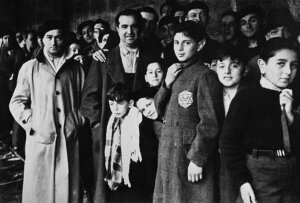
The political and ideological landscape of France has changed dramatically over the past quarter-century. In 1995, the Gaullist right and Socialist left were the country’s dominant parties. Though they collided on a range of economic and social issues, they both cleaved to the values of the Republic. As for the Front National, while Le Pen won 15% of the vote in the 1995 presidential election, most political commentators believed it would always remain a fringe movement.
This comforting conviction collapsed after the presidential and legislative elections earlier this year. While the candidates from the traditional left and right were quickly dispatched in the first round of voting, Marine Le Pen, who inherited her father’s party in 2011, won a stunning 41% of the vote in the second round of the presidential race. As for her party — rebranded with a more consensual and less confrontational name, the National Rally — it won an even more stunning 89 seats in the legislative contest, just second to Macron’s own party.
Though Le Pen has sought to “de-demonize” her father’s party, ridding its ranks of blatant antisemites and Vichy apologists, it remains deeply xenophobic, with Muslims replacing Jews as the usual suspects behind France’s ills. And like her father, Marine Le Pen insists that, unlike the traditional parties on the left and right, she and her followers alone are the true French nationalists. While this claim can be disputed, what cannot be disputed is the fact that the National Assembly’s largest opposition party springs from the toxic soil of French antisemitism.
French Jews are understandably sensitive to this issue. This is made manifest in the inscription below the Spitzer statue unveiled in 1995: “The French Republic pays homage to the racist and antisemitic persecutions and crimes against humanity committed under the de facto authority called ‘the government of the French state’ 1940-1944.”
What the nation gives, the nation can also take away. This was the case with Vichy, which paved the path to Auschwitz by effectively stripping French Jews of their rights in 1940. This is, indirectly, also true for Le Pen’s demand that “national priority” become a constitutional right. The proposed law, which would block non-citizens from seeking employment, housing, health care and social benefits, would mean that, overnight, millions of families would be deprived of the rights they have long taken for granted.
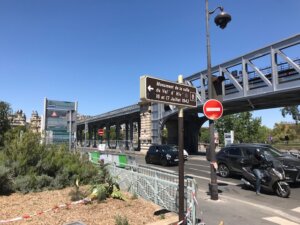
Rooted in this transformed political landscape, what can we expect of memorials and monuments? “Not much,” I thought yesterday when I visited both the plaque and statue, two days before the official ceremony to mark the 80th anniversary. Representing the French state on that day will be Elisabeth Borne, who Macron named last month as his new prime minister. Her father, Joseph Borne, né Bornstein, joined a French Jewish resistance organization in 1943. Captured by the Gestapo, he was sent to Auschwitz. Though he survived the death camp, Borne eventually took his own life in 1972.
There will be a crowd come Sunday, but when it disperses, the monuments will return to what they were today: sites unseen on a sweltering summer day. It is almost as if we erect them to forget what they call on us to remember. “There is nothing in this world as invisible as a monument,” observed the Austrian novelist Robert Musil. “They are no doubt erected to be seen — indeed, to attract attention. But at the same time, they are impregnated with something that repels attention.”
This invisibility is especially insidious when it comes to Holocaust memorials. As I watched cyclists pedal and couples stroll past the stele, I imagined the command “Passant, souviens-toi!” was little more than a blur. Perhaps it was the intense afternoon heat rising from the pavement, perhaps it was the bateaux-mouches on the Seine, perhaps it was the prospect of a cold drink at a café that distracted them. Of course, I was also thinking of a cold drink. But I could not help but also think of a remark made by the French philosopher Jean Baudrillard: “Forgetting the extermination is part of the extermination itself.”
